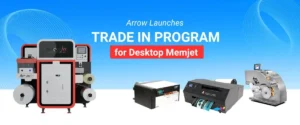Table of Contents
How does an industrial inkjet printer work?
Every workplace will have a printer, be it color or black and white ink printer. These printers may fall under the categories of inkjet printers.
What is an Inkjet Printer?
You see a print out from your office printer. Take a closer look at the print out when it pops out of your printer. You will see the ink settling in on the paper. The inkjet printer places very small droplets of inks on the paper and these tiny droplets combine together to form the print user desires.
Now these droplets or dots are very small. Their diameter exists between 50 to 60 microns. Yes, it is that small, even smaller than the diameter of a human hair. The inkjet printer throws these dots on paper, meaning it does not touch the paper rather it sprays dots and prints out the required print design or template.
Inkjet printers have seen a surge in demand and popularity since its inception. The growing popularity has brought the prices down of these printers. Hence making it attractive for customers.
Industrial Inkjet printers
The use of label printers have seen an exponential growth because of the inkjet printing system.
Industrial label printers use inkjet technology for label printing. There are a couple of inkjet print systems: Scan printing and Single pass printing. There are also 2 main types of inkjet technologies used by industrial printer manufacturers: Thermal bubble and Piezoelectric.
Let us take a long dive into these different print systems and technologies, respectively.
Scanning Printing
With scan printing, the print head used in the printer retaliates the direction of the print laterally with respect to the print media used. This print system takes multiple passes to finish the printing process, while the media is fixed in the underlying surfaces.
The system will laterally spray the dots of ink carried from the ink tanks passing through the print head and spraying the ink via nozzles on the materials.
Single-Pass Printing
For an optimum Digital printing experience, the print head carriage stays in one fixed position. The print media or the material used will move using the help of a flat surface which unwinds and rewinds as necessary.
The inks are sprayed on the media and the print is finished in a single pass.
Single pass printing is widely used in the industrial inkjet printers because of its high speed printing capabilities.
Digital printing generally requires high productivity and also uses the form of volume printing. Bulk orders are printed quite efficiently with a single pass print system.
The two main technologies used by industrial inkjet printers:
Thermal Bubble
Thermal bubble jet systems create tiny bubbles of ink and are sprayed using the nozzle through a print head on the media. There are small resistors which create heat. The heat vaporizes ink into bubbles.
These bubbles then expand gradually and pop out via a nozzle onto the paper. When the bubble collapses it creates a vacuum and that pulls the ink from ink cartridges to the print head.
Finally, bubbles are created and spayed simultaneously and rapidly.
Piezoelectric or Piezo Print Heads
This technology is patented by EPSON and creates high quality prints. It uses an electric charge paired with piezo crystal to spray out the inks when the user commands.
A crystal is located behind the nozzle’s ink reservoir, where a vibration is caused electronically. During the electric charge, the crystal experiences an inward vibration and the nozzle throws out the ink in small amounts.
When the electric charge causes an outward vibration, the nozzle pulls the ink back to the reservoir to replace the ink sprayed out.
Now that we have understood the types of systems involved in industrial inkjet printers along with the technologies.
Let us walk through together different types of inks which inkjet printers use.
Dye based Ink
Dye based inks contain colorants which dissolve into deionized water. Many optical compounds are added to increase vibrancy of the colors. Dye based inks are widely used in many industrial label inkjet printers. This type of ink is best preferred for everyday use printing.
Colordyne’s 1800 Series C Digital Inkjet Printer uses dye based inks to print out high quality labels and also uses a cutting edge system to cut the labels efficiently.
1800-C can support upto 250ML ink cartridges of Cyan, Magenta, Black and Yellow colors each.
Pigment based Ink
Pigmented inks are formed from fine color powders when suspended in liquid form. The inks when evaporated from the media makes the printed design look attractive and appealing.
Pigment ink printers are best used to print out labels and professional photos. Pigment inks can resist ultraviolet light better than dye based inks.
Arrowjet Aqua 330R is the latest pigment inkjet printer to give the best quality prints at high levels of production.
It is Arrow System’s latest digital printer with laser finishing system and a print engine supported by Memjet’s Duraflex technology.
Ultraviolet (UV) Ink
Ultraviolet (UV) based inks are a combination of monomer liquid and polymer powder, which then results in acrylic monomer. UV inks will consist of the acrylic monomer and a photo-initiator which is very important for UV printing.
The UV inks do not evaporate and once the inks hit the media surface and the media is exposed to UV LED light which will cause a chemical reaction and make sure that the UV inkjet printer prints solid labels or images.
Take a look at Colordyne 3600 UV Retrofit printer.
It is best used for printing barcodes labels, text, trade show labels and also merges other databases very easily. UV inkjet printer with the ability to convert into a hybrid digital web press which can use water based inks including all colors.
Solvent Ink
Solvent based inks are similar to pigment inks. But the only difference is solvent inks use volatile organic compounds in the aqueous formula.
Solvent inks also dry rapidly through evaporation and can result in high speed printing.
Solvent inks are mostly used on uncoated vinyl surfaces and we can find billboards and banners using solvent inks.
Mimaki’s CJV150 Series uses eco solvent inks for high quality printer progress. Eco solvent comes with 8 color options which also includes silver, white, orange and light black inks.
Now that we see the end of this blog, let us summarize how an industrial inkjet printer works.
An inkjet printer needs a print system, Scan printing or Single pass printing.
Then there are a couple types of technologies used by an inkjet printer, Thermal Bubble and Piezoelectric.
Lastly, the types of inks which are very important for an inkjet printer to run and they are: Dye based, Pigment based, UV based and Solvent based inks.
For more information on different types of printers other than inkjet printers please visit
Arrow Systems, Inc. joins forces with Wolff Poligrafia to ignite a wave of digital label & pouch innovation across Poland
Table of Contents Arrow Systems, Inc. joins forces with Wolff Poligrafia to ignite a wave of digital label & pouch innovation across Poland In a

Breaking News: Arrow Systems Partners with BUSINESSWARE to Transform Digital Printing Across Greece & Cyprus
Table of Contents Breaking News: Arrow Systems Partners with BUSINESSWARE to Transform Digital Printing Across Greece & Cyprus Arrow Systems, Inc. is excited to announce

Sid Sistemas de Impresión in Spain Installs ArrowJet Aqua 330R and DPR Taurus to Bolster Label Production
Table of Contents Sid Sistemas de Impresión in Spain Installs ArrowJet Aqua 330R and DPR Taurus to Bolster Label Production Arrow Systems, Inc., in collaboration

Step Inside Innovation: Arrow Systems New Experience Center Opens in Ontario, Canada.
Table of Contents Step Inside Innovation: Arrow Systems New Experience Center Opens in Ontario, Canada. If there’s one thing the printing industry thrives on, it’s

Arrow Launches Trade In Desktop Printers
Table of Contents Arrow Launches Trade In Program for Desktop Memjet Printers Let’s be honest, your old Afinia, VIPColor, or Trojan printer has probably earned

Arrow Systems, Inc., partners with Capital Mailing Equipment expanding access to next-generation Digital Printing Solutions across North America
Arrow Systems, Inc., partners with Capital Mailing Equipment expanding access to next-generation Digital Printing Solutions across North America Arrow Systems, Inc., a global innovator in
